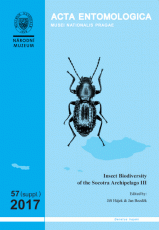Bees of the Socotra Archipelago (Hymenoptera: Anthophila), their biogeography and association with parasites
Straka Jakub, Batelka Jan, Pauly Alain
Acta Entomologica Musei Nationalis Pragae 57(supplementum): 183-219, 2017
Published online: 31st December 2017
Views: 1444
Abstract: Taxonomy of bees (Hymenoptera: Anthophila) of the Socotra Archipelago is
evaluated based on historical and newly available specimens. Four new species of
Halictidae are described from the Socotra Island: Austronomia socotrana Pauly
& Straka sp. nov., Lasioglossum (Hemihalictus) boswelliae Pauly & Straka
sp. nov., Lasioglossum (Sphecodogastra) dioscoridis Pauly & Straka sp. nov.,
and Lasioglossum (Ctenonomia) dracaenae Pauly & Straka sp. nov. The correct
original spelling of Eucera wfkirbyi Kohl, 1906 is restored, Eucera kirbyi
Friese, 1909 being its unjustifi ed emendation and junior objective synonym.
Identity of both Socotran species of Xylocopa Latreille, 1802 is clarifi ed.
Lasioglossum (Evylaeus) kowitense (Cockerell, 1937), Nomioides facilis (Smith,
1853), and Nomioides rotundiceps Handlirsch, 1888 are removed from the list of
bees of Socotra. In total, 28 species in 16 genera are reported from the
archipelago, of which nearly two thirds are considered endemic at the species
level. Biogeographic origin of Socotran bees is analysed and proposed. Host
associations with beetle parasites of the families Meloidae and Ripiphoridae
(Coleoptera) and cleptoparasitic bees are evaluated for the Socotran bee fauna.
Obligate bee parasitoid Ripiphorus arabiafelix arabiafelix Batelka, 2009
(Coleoptera: Ripiphoridae) is reported from the archipelago (Socotra Island) for
the fi rst time.
Key words: Coleoptera, Curculionoidea, Brachyceridae, Brachycerus, taxonomy, new species, morphology, genitalia, Yemen, Socotra
Papers
Insect biodiversity of the Socotra Archipelago – underlined and countedNew species and new distributional data on Carabidae (Coleoptera) from the Socotra ArchipelagoHisteridae of Socotra (Coleoptera: Histeroidea)Canuschiza of Socotra Island (Coleoptera: Scarabaeidae: Melolonthinae) Part 2. Canuschiza minuta species groupStomanomala subcostata (Coleoptera: Scarabaeidae), the fi rst record of ruteline chafer from Socotra Archipelago, YemenFirst record of the family Cantharidae on Socotra, with description of a new genus and two new species of the subfamily Silinae (Coleoptera: Elateroidea)Bostrichidae (Coleoptera) of Socotra with description of two new subspeciesCleridae (Coleoptera) from Socotra Island with description of new speciesColotrema socotrana sp. nov. from Socotra Island, with new records of the genus from Yemen (Coleoptera: Malachiidae)First record of the family Sphindidae (Coleoptera: Cucujoidea) from SocotraA taxonomic review of the genus Clitobius with description of a new species from Oman (Coleoptera: Tenebrionidae)Longitarsus doeberli, a wingless new species from Socotra Island (Coleoptera: Chrysomelidae)A new species of Brachycerus from Socotra Island (Coleoptera: Curculionoidea: Brachyceridae)Bees of the Socotra Archipelago (Hymenoptera: Anthophila), their biogeography and association with parasitesEurema brigitta ( Lepidoptera: Pieridae) – a new record of butterfly for Socotra 